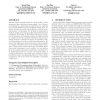Free Online Productivity Tools
i2Speak
i2Symbol
i2OCR
iTex2Img
iWeb2Print
iWeb2Shot
i2Type
iPdf2Split
iPdf2Merge
i2Bopomofo
i2Arabic
i2Style
i2Image
i2PDF
iLatex2Rtf
Sci2ools
WSNA
2003
ACM
2003
ACM
Analysis on the redundancy of wireless sensor networks
Wireless sensor networks consist of a large number of tiny sensors that have only limited energy supply. One of the major challenges in constructing such networks is to maintain long network lifetime as well as sufficient sensing area. To achieve this goal, a broadly-used method is to turn off redundant sensors. In this paper, the problem of estimating redundant sensing areas among neighbouring wireless sensors is analysed. We present an interesting observation concerning the minimum and maximum number of neighbours that are required to provide complete redundancy and introduce simple methods to estimate the degree of redundancy without the knowledge of location or directional information. We also provide tight upper and lower bounds on the probability of complete redundancy and on the average partial redundancy. With random sensor deployment, our analysis shows that partial redundancy is more realistic for real applications, as complete redundancy is expensive, requiring up to 11 ne...
Related Content
| Added | 05 Jul 2010 |
| Updated | 05 Jul 2010 |
| Type | Conference |
| Year | 2003 |
| Where | WSNA |
| Authors | Yong Gao, Kui Wu, Fulu Li |
Comments (0)

